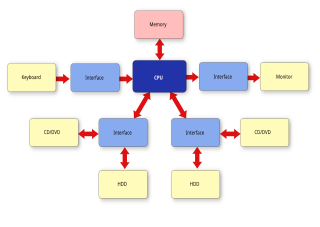
Computer security, cybersecurity, digital security or information technology security is the protection of computer systems and networks from attacks by malicious actors that may result in unauthorized information disclosure, theft of, or damage to hardware, software, or data, as well as from the disruption or misdirection of the services they provide.

Multics is an influential early time-sharing operating system based on the concept of a single-level memory. Nathan Gregory writes that Multics "has influenced all modern operating systems since, from microcomputers to mainframes."
An intrusion detection system is a device or software application that monitors a network or systems for malicious activity or policy violations. Any intrusion activity or violation is typically either reported to an administrator or collected centrally using a security information and event management (SIEM) system. A SIEM system combines outputs from multiple sources and uses alarm filtering techniques to distinguish malicious activity from false alarms.
Jerome Howard "Jerry" Saltzer is an American computer scientist.
A federated identity in information technology is the means of linking a person's electronic identity and attributes, stored across multiple distinct identity management systems.

A system architecture is the conceptual model that defines the structure, behavior, and more views of a system. An architecture description is a formal description and representation of a system, organized in a way that supports reasoning about the structures and behaviors of the system.
Michael Schroeder is an American computer scientist. His areas of research include computer security, distributed systems and operating systems and he is perhaps best known as the co-inventor of the Needham–Schroeder protocol. In 2001 he co-founded the Microsoft Research Silicon Valley lab and was the assistant managing director until the lab was disbanded in 2014.
SecPAL is a declarative, logic-based, security policy language that has been developed to support the complex access control requirements of large scale distributed computing environments.
Virgil Dorin Gligor is a Romanian-American professor of electrical and computer engineering who specializes in the research of network security and applied cryptography.
A device fingerprint or machine fingerprint is information collected about the software and hardware of a remote computing device for the purpose of identification. The information is usually assimilated into a brief identifier using a fingerprinting algorithm. A browser fingerprint is information collected specifically by interaction with the web browser of the device.
Computer security software or cybersecurity software is any computer program designed to influence information security. This is often taken in the context of defending computer systems or data, yet can incorporate programs designed specifically for subverting computer systems due to their significant overlap, and the adage that the best defense is a good offense.
Security information and event management (SIEM) is a field within the field of computer security, where software products and services combine security information management (SIM) and security event management (SEM). They provide real-time analysis of security alerts generated by applications and network hardware. Vendors sell SIEM as software, as appliances, or as managed services; these products are also used to log security data and generate reports for compliance purposes. The term and the initialism SIEM was coined by Mark Nicolett and Amrit Williams of Gartner in 2005.
In information security, computer science, and other fields, the principle of least privilege (PoLP), also known as the principle of minimal privilege (PoMP) or the principle of least authority (PoLA), requires that in a particular abstraction layer of a computing environment, every module must be able to access only the information and resources that are necessary for its legitimate purpose.
Privacy engineering is an emerging field of engineering which aims to provide methodologies, tools, and techniques to ensure systems provide acceptable levels of privacy.
Elena Ferrari is a Professor of Computer Science and Director of the STRICT Social Lab at the Università degli Studi dell’Insubria, Varese, Italy. Ferrari was named Fellow of the Institute of Electrical and Electronics Engineers (IEEE) in 2013 for contributions to security and privacy for data and applications. She has been named one of the “50 Most Influential Italian Women in Tech” in 2018. She was elected as an ACM Fellow in 2019 "for contributions to security and privacy of data and social network systems".
Saltzer and Schroeder's design principles are design principles enumerated by Jerome Saltzer and Michael Schroeder in their 1975 article The Protection of Information in Computer Systems, that from their experience are important for the design of secure software systems.
This is a list of cybersecurity information technology. Cybersecurity is security as it is applied to information technology. This includes all technology that stores, manipulates, or moves data, such as computers, data networks, and all devices connected to or included in networks, such as routers and switches. All information technology devices and facilities need to be secured against intrusion, unauthorized use, and vandalism. Additionally, the users of information technology should be protected from theft of assets, extortion, identity theft, loss of privacy and confidentiality of personal information, malicious mischief, damage to equipment, business process compromise, and the general activity of cybercriminals. The public should be protected against acts of cyberterrorism, such as the compromise or loss of the electric power grid.
Security Controls for Computer Systems, commonly called the Ware report, is a 1970 text by Willis Ware that was foundational in the field of computer security.
The Lincoln Adaptable Real-time Information Assurance Testbed (LARIAT) is a physical computing platform developed by the MIT Lincoln Laboratory as a testbed for network security applications. Use of the platform is restricted to the United States military, though some academic organizations can also use the platform under certain conditions.
Confidential computing is a security and privacy-enhancing computational technique focused on protecting data in use. Confidential computing can be used in conjunction with storage and network encryption, which protect data at rest and data in transit respectively. It is designed to address software, protocol, cryptographic, and basic physical and supply-chain attacks, although some critics have demonstrated architectural and side-channel attacks effective against the technology.


